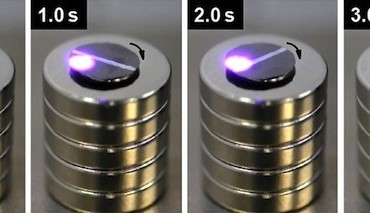Light Controlled Levitating Magnets
January 03, 2013
on
on

Using only permanent magnets and a light source Japanese scientists have succeeded in controlling the motion of a magnetically levitating graphite disk. The technique can be used to develop light-powered maglev transportation systems and to convert sunlight into kinetic energy.
For their experiment Dr. Masayuki Kobayashi and Professor Jiro Abe of Aoyama Gakuin University in Kanagawa, Japan exploited the diamagnetic properties of pyrolytic graphite. When graphite is exposed to an external magnetic field it generates is own repelling magnetic field. This property called diamagnetism is found in all materials but is usually very weak. Only in a few materials, like graphite, diamagnetism is so strong it causes levitation.
Levitating diamagnetic objects can be put in motion in one of two ways. The first is to manipulate the magnetic field on which the object floats. A maglev train, for instance, is propelled forward by system of changing magnetic fields pulling at the front of the train while pushing at the back.
The second is to change the diamagnetic properties of the floating object. Kobayashi and Abe are the first in the world to actuate a levitating diamagnetic object without manipulating the magnetic field or physically touching it.
To do this they formed a lattice of neodymium magnets –which have a strong and persistent magnetic field- and let the graphite disk levitate on top of it. Then they exposed the graphite to a laser beam causing the material to heat up. As temperature increases the object moves downward.
This is because the rising temperature weakens the diamagnetic properties of the disk, lowering its magnetic susceptibility. Forward movement is induced when the laser hits only a small part of the disk. The magnetic field becomes unevenly distributed causing the disk to move in the same direction as the beam.
When this phenomenon is applied on a bigger scale, the scientists say, it can be used to develop a light-driven maglev transportation system.
In another experiment the disk was put on a cylindrical magnet keeping the disk in one place. When the edge of the disk was hit with the light beam, it caused a rotational movement. When exposed to sunlight the disk reached a rotational speed of 200 rounds per minute.
Using magnetic levitation to convert sunlight into rotational kinetic energy could be applied to develop a new class of light energy conversion system.
Kobayashi and Abe had their paper Optical Motion Control of Maglev Graphite published in the December issue of the Journal of the American Chemical Society.
Sources: Phys.org, Blogs.discovery.com
For their experiment Dr. Masayuki Kobayashi and Professor Jiro Abe of Aoyama Gakuin University in Kanagawa, Japan exploited the diamagnetic properties of pyrolytic graphite. When graphite is exposed to an external magnetic field it generates is own repelling magnetic field. This property called diamagnetism is found in all materials but is usually very weak. Only in a few materials, like graphite, diamagnetism is so strong it causes levitation.
Levitating diamagnetic objects can be put in motion in one of two ways. The first is to manipulate the magnetic field on which the object floats. A maglev train, for instance, is propelled forward by system of changing magnetic fields pulling at the front of the train while pushing at the back.
The second is to change the diamagnetic properties of the floating object. Kobayashi and Abe are the first in the world to actuate a levitating diamagnetic object without manipulating the magnetic field or physically touching it.
To do this they formed a lattice of neodymium magnets –which have a strong and persistent magnetic field- and let the graphite disk levitate on top of it. Then they exposed the graphite to a laser beam causing the material to heat up. As temperature increases the object moves downward.
This is because the rising temperature weakens the diamagnetic properties of the disk, lowering its magnetic susceptibility. Forward movement is induced when the laser hits only a small part of the disk. The magnetic field becomes unevenly distributed causing the disk to move in the same direction as the beam.
When this phenomenon is applied on a bigger scale, the scientists say, it can be used to develop a light-driven maglev transportation system.
In another experiment the disk was put on a cylindrical magnet keeping the disk in one place. When the edge of the disk was hit with the light beam, it caused a rotational movement. When exposed to sunlight the disk reached a rotational speed of 200 rounds per minute.
Using magnetic levitation to convert sunlight into rotational kinetic energy could be applied to develop a new class of light energy conversion system.
Kobayashi and Abe had their paper Optical Motion Control of Maglev Graphite published in the December issue of the Journal of the American Chemical Society.
Sources: Phys.org, Blogs.discovery.com
Read full article
Hide full article


Discussion (2 comments)